A Day at Econe
by Douglas Laudenschlager
6:00 A.M. — A four-tone chime announces the beginning of another day of prayer and study at the International Seminary of Saint Pius X in Ecône, Switzerland. Each seminarian resolutely clambers out of bed and onto his knees to make his morning offering of all the day's work and trials, in union with Our Lord's offering of Himself in Holy Mass. He then has about a half-hour to wash and dress. He pulls up his blind and looks out on the seminary's vineyards, the Rhone River valley, and the Alps rising beyond; and around his own small room, with his bed and desk and bookshelves and closet and sink. As he dons his cassock, he repeats the Psalm verse that he recited along with the Bishop at the moment of his first tonsure: "The Lord is the part of my inheritance . . ." Then he leaves his room for the chapel, where the community's day naturally begins, and where he will find some of the priests and older seminarians already kneeling at their places silently praying the Divine Office. The hall outside the chapel is a flurry of black and white as the hundred or so seminarians put on their surplices, take their missals and breviaries, and head for their places in chapel.
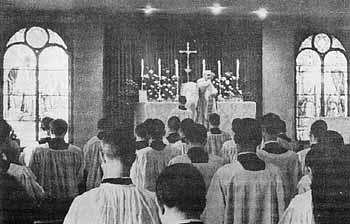
6:30 A.M. — At a signal, everyone rises, and the recitation of Prime, the early morning hour of the Church's official prayer, begins. The two sides of the choir alternate the verses of the Psalms, then in magnificent prayers the officiating priest calls down the graces which all will need in the accomplishment of their daily duties. At the end of Prime, everyone kneels for a half-hour of silent meditation, to grow in the intimate knowledge and love of Our Blessed Lord, whom priests are called to imitate in such a special manner.
7:15 A.M. — Soon after the recitation of the Angelus, at the end of the period of meditation, daily low Mass begins. Some seminarians have left to serve the Masses of other priests at other altars. The rest remain kneeling, most with missals before them, to take part in the central act of worship of the Sacred Liturgy, the unbloody renewal of the Sacrifice of Calvary, offering themselves with Our Lord on the altar, and begging by the infinite value of this perfect sacrifice the graces they will need that day, and in their future apostolate. Archbishop Lefebvre often recalls how the Mass should be the center of the priest's and seminarian's day, imitating in this the Society's holy patron, Saint Pius X. "For Saint Pius X," his successor, Pope Pius XII, declared, "the altar and the Eucharistic Sacrifice were the essential and the center of his piety, his refuge and his strength in trials and difficulties. They were his source of light and of courage, the source of his untiring zeal for the glory of God and the salvation of souls." At this daily Mass all the seminarians receive Holy Communion and remain some time afterwards in silent thanksgiving.
8:00 A.M. — Then the chime summons all to the community refectory for a light European breakfast, consisting of cafe au lait (coffee and milk) drunk from a bowl, and bread and butter. Everyone eats in silence, and the seminarian may leave when he has finished to prepare for the morning's classes, set his room in order, or accomplish some of the maintenance chores that might have been assigned to him that week.
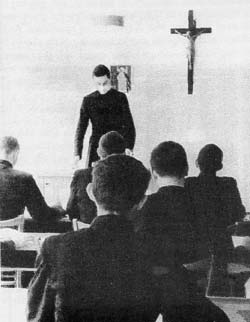 |
9:00 A.M. — Then the real day's work begins with the first of three classes in large, well-lit classrooms. All the professors teach in French, except one visiting Italian priest who has as much trouble with French as some foreign seminarians do and has to teach in Latin. Most of the European professors, however, know sufficient English to permit American seminarians to do their semester oral and written examinations in their own language. The class lasts fifty minutes, and in the ten minutes remaining before the next class, the seminarians gather in small groups in the room or the hall to question the professor, argue good-naturedly about points brought up in class, exchange news from their countries, . . . discuss their plans for the next afternoon off. Two more classes at 10:00 and 11:00 end the morning's activities, and the seminarians have the time to take their books back to their rooms and spend some time reading Sacred Scripture, for example, before the bell rings again.
12:15 P.M. — The seminarians all return to chapel for the recitation of Sext, the midday prayer of the Church. The Angelus follows once again before all head for the refectory and the midday meal, prepared by a local layman aided by the Brothers stationed at Ecône. The students are arranged at tables of six, often representing as many as six different nationalities of the twelve represented at the seminary. After prayers before meals, all sit and listen to a short passage from the Holy Gospels, then during the first part of the meal one of the seminarians reads from a book of historical interest chosen by a professor. Recent readings have included the life of Dom Prosper Gueranger and the memoirs of Cardinal Mindszenty. The same procedure is followed at the evening meal, but the reading is taken from the life of a Saint. After the Archbishop or the Director has rung the bell, the reading ceases and conversation begins.
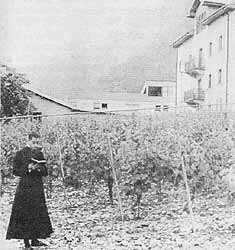 |
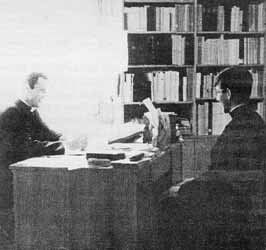 |
At the end of the meal, after prayers, the seminarians drift out into the corridors for the hour of rec, with a wide variety of activities to choose from—a visit to the bookstore, a walk on the country roads around the seminary, a game of volleyball or soccer, or of chess if it is raining, or maybe even a snowball battle in winter. Wednesday and Sunday the seminarians have the entire afternoon free and can plan to shop in nearby Martigny or Sion, if necessary, or take a longer hike with friends in the mountains.
2:00 P.M. — The bell signals the end of recreation and everyone has time for the afternoon's classes or study, perhaps after a visit to the Blessed Sacrament. The seminarian may have classes at 2:15 and 3:10; if he does not every day, he may study or read, in his room or in the seminary library, which also contains a large and well-stocked section of English language books.
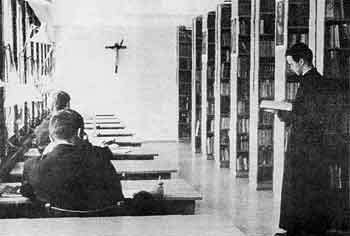
4:00 P.M. — Both seminarians and professors welcome this hour and fifteen-minute snack of tea and bread and jam served in the refectory, affording a few minutes' diversion from the pressures of note-taking and intensive study. After tea, many go to the chapel to pray the breviary, or take a short walk outside before returning to their rooms or the library to continue work until 6:00 or 6:30. For others, it may be time during this weekly visit to their spiritual director, for confession and encouragement on their life of study and prayer.
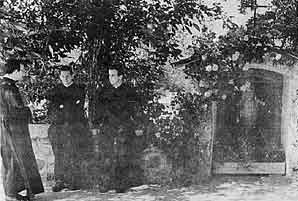
6:00 P.M. — On Tuesday and Saturday, the whole seminary gathers for Gregorian chant practice for the Masses of the next Sunday and other feast days. The students of the Year of Spirituality have a practice at this hour every night so as to become thoroughly familiar with the sacred music of the Church in which they might have to instruct others one day.
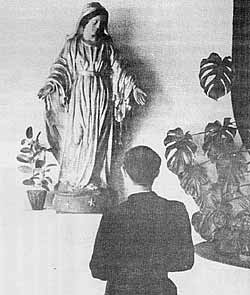 |
6:30 P.M. — A spiritual conference by one of the priests follows chant practice. This deals either with an aspect of the spiritual life or with the present feast or season of the liturgical year. Each Saturday the Director of the Seminary addresses the seminarians on the observance of the Rule and other aspects of community life.
7:00 P.M. — Finally, the seminarians return to the chapel once again to recite the Holy Rosary for the intentions of all the friends and benefactors of the Society of Saint Pius X. On Thursday, however, there is Benediction of the Blessed Sacrament, and on Friday, the Stations of the Cross, for which a different seminarian writes the meditations each week. The Angelus follows before the evening meal at 7:30.
After supper, another recreation period follows, and the seminarians normally walk outside in small groups discussing anything from the day's studies to the world-wide development of the Society of Saint Pius X. At 8:45 the bell summons all to the chant of the Church's official night prayer, the hour of Compline. Most priests and students stay in the chapel for a while afterwards to pray longer or make their examination of conscience and resolutions for the following day. By 10:00 everyone has retired for the night—and usually without any reluctance, after a very full day!
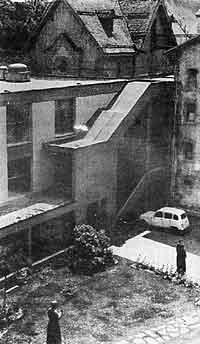 |
|
This, then, is daily life at the International Seminary of St. Pius X in Ecône, Switzerland. On Sunday, the schedule varies slightly, with Solemn Mass in mid-morning and Solemn Vespers with Benediction in late afternoon. In the United States, Father Donald Sanborn, Rector of the Society's English-speaking seminary, presently located at Armada, Michigan, has modified the schedule on certain points to conform better to American customs. The seminary will open in Armada this year with four permanent priest-confessors and almost twenty-five students in the first and second years of studies. Soon, with the eventual addition of a new professor or two, American young men will have a complete seminary formation available to them here in the United States, under very capable priests trained at Ecône under Archbishop Lefebvre.
In conclusion, we commend the Society of Saint Pius X, with Archbishop Lefebvre and all his priests and seminarians, to the daily prayers of all our friends and benefactors. Only with the aid of your prayers can we bear the priest's special cross and truly be "other Christs" as our sublime vocation demands.
MR. LAUDENSCHLAGER is a seminarian at Ecône. He received the Orders of Subdiaconate on June 29, 1978, and will be ordained by Archbishop Lefebvre on June 29, 1979.
